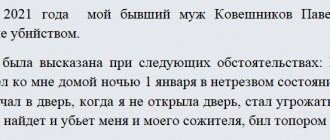Bookmarked: 0
What is robbery? Description and definitions of the concept.
Robbery is a type of theft of property, which is distinguished by the fact that this theft is carried out openly, which means in the presence of strangers or the owner of the thing. In addition, unauthorized persons or the owner of the property realize that a crime is being committed in their presence. Robbery may be accompanied by violence that is not dangerous to health or life. In the criminal legislation of many countries, robbery is not considered as a separate crime, and the concept of robbery is included in the theft or robbery. The robbery can be considered completed if the perpetrator has taken the property and has the opportunity to dispose of it for his own purposes or for the purpose of sale.
Robbery (Article 161 of the Criminal Code of Russia) is the open theft of someone else's property. It can be expressed in the theft of property, which was committed without violence against the person or with the use of violence that is not dangerous to life and health. Thus, robbery is different from theft (the secret theft of someone else's property) and robbery (an attack with the aim of stealing someone else's property, which involves the use of violence dangerous to life or health, or the threat of its use). In many countries, robbery is not identified as an independent crime, but is covered by theft (hidden theft of property) or robbery (theft of someone else's property with the use of violence).
The robbery is considered completed when the property is confiscated and the perpetrator is given a real opportunity to use it or dispose of it at his own discretion (for example, to use the stolen property for his own benefit or for the benefit of other persons, to dispose of it for personal gain in any other way.
Introduction
The realities of the modern world determine the life of every person. The difficult economic situation caused by the global economic crisis, uncontrolled access to the Internet and television, deterioration in the quality of life and prosperity are prerequisites for the aggravation of the criminological situation in society. As a result, attempts to illegally acquire someone else's property are becoming more and more frequent, and methods of such acquisition are taking on new forms.
The relevance of the fight against encroachment on the property rights of citizens is due to the need for comprehensive protection of their property rights.
In criminal legislation, liability for property crimes is differentiated depending on the method of committing property crimes. Confiscation can be secret or open, violent or non-violent, through deception or abuse of trust, etc. Methods of confiscation of property as objective circumstances characterizing theft have a significant impact on the degree of public danger of the crime and are therefore taken into account by the legislator.
Yes, Art. 161 of the Criminal Code of the Russian Federation (hereinafter referred to as the “Criminal Code of the Russian Federation”) defines robbery as “open theft of someone else’s property.”
The course work attempts to present the general characteristics of robbery as a crime, as well as to determine its characteristics and forms of implementation.
Subject
According to the Criminal Code, the value of what was stolen for robbery does not matter . “Petty” robbery, unlike other types of theft, does not exist. Although in each situation all the circumstances of the incident and the danger of the act must be assessed.
Robbery
- If the wife does not in any way prevent Ivan from taking the phone from the bench, then there will be no sign of “openness” of the encroachment in this case. Ivan believes that he is acting secretly, since his wife, due to family ties, will not prevent him from accomplishing his plan. Therefore, his actions will be considered theft (secret theft, Article 158 of the Criminal Code of the Russian Federation).
- If the wife objects and tells Ivan “don’t touch it!”, and also tries to prevent his actions, then there is a sign of open encroachment. Consequently, Ivan will be held liable under Art. 161 of the Criminal Code of the Russian Federation (robbery).
In such cases, judicial practice qualifies actions as robbery, and not as theft. In this situation, the victim is aware of the initial process of taking possession of property and objectively perceives what is happening (although he may not see the face of the criminal).
Property crimes
Property concept
The concept of property has accompanied humanity since the very beginning of its development. Human development, the formation of various forms of social relations and their transformation have had a significant impact on forms of ownership and the formation of ideas about the ownership of material goods. Individualization of a person has become a prerequisite for the individualization of property relations and the transfer of the function of protecting property to the state.
At the dawn of human evolution, property relations represented an exaggeration of the importance of owning a thing, while the theft of property represented its actual removal and transfer to another point in space. The concept of property was not separated, and the objects of encroachment were mainly material movable objects. Since the volume of physical goods was small, the number of encroachments on them was also not significant. At the same time, the function of protecting property was entirely dependent on the owners, who were the real owners of things at that time in human history, and depended largely on their physical abilities.
At this stage of development of property relations, there was no distinction between property offenses - theft, robbery, retention, appropriation of someone else's property were defined as “theft”. The development of property relations required strengthening the role of the state in protecting property, and there was a need for public responsibility for violation of the rights of owners. Gradually, the guarantee of protection of the rights of the owner and the stability of these rights came from the state, which created the appropriate conditions for the protection of these rights by creating appropriate legislation. With the development of legislation, property crimes, previously united by the general concept of “theft,” began to be divided into different terms - theft, robbery, robbery, appropriation of someone else’s property.
Property crimes
When talking about robbery as one of the crimes against property, one cannot fail to mention the category of acts.
Property crimes are socially dangerous actions that violate the owner’s rights to possession, use and disposal or otherwise cause (or threaten to cause) damage to property. The subject of any property offense is the publicity of property (ownership, use and disposal of property) and the right of legal ownership of property. The object of property offenses is all material objects that are not excluded from general civil circulation and have a consumer value (price).
The subject of property offenses can be a responsible individual who has reached 14 or 16 years of age. The subjective side of most property crimes is characterized by guilt in the form of direct intent, and only destruction or damage to someone else’s property can be committed with direct or indirect intent or through carelessness or negligence. A mandatory feature of most crimes against property is a selfish motive and the goal of obtaining illegal profit.
In accordance with the Criminal Code, all property crimes are divided into three groups depending on their immediate purpose, method and motive:
- Theft - theft (Article 158), fraud (Article 159), misappropriation or embezzlement (Article 160), robbery (Article 161), robbery (Article 162) and theft of items of special value (Article 164);
- Other mercenary attacks - extortion (Article 163), damage to property by deception or abuse of trust (Article 165) and illegal theft of a car or other vehicle without the purpose of theft (Article 166);
- Unselfish assault is the intentional destruction or damage of property (Criminal Code, Art. 167) or destruction or damage of property due to negligence (Criminal Code, Art. 168).
To bring a person to criminal responsibility and find him guilty, it is necessary to prove that the acts he committed constitute a specific crime, which is the basis for criminal liability in accordance with the Criminal Code of the Russian Federation.
Insignificance
For committing theft, a person may be subject to either administrative or criminal liability. The type of liability depends on the size of the stolen property.
As for robbery, Art. 7.27 of the Code of Administrative Offenses (petty theft) cannot be applied to open theft. The legislator does not provide for administrative liability for robbery, even if the amount of stolen property does not exceed 1,000 rubles.
— What happens if a person commits robbery, but the amount stolen is so small that it would be strange to talk about criminal liability?
For such cases, the legislator has provided for the category of insignificant act (Part 2 of Article 14 of the Criminal Code of the Russian Federation). Thus, a person cannot be held criminally liable for actions that formally fall under the signs of robbery, but do not pose a public danger due to their insignificance.
Despite the fact that the nature and degree of public danger of a particular act are considered by the court individually, taking into account all the circumstances, it is very important that the person initially planned to commit a minor act. That is, if a person intended to steal property worth one amount, but due to some circumstances stole property worth a smaller amount, then the act is not insignificant.
Let's look at two examples from life:
- Ivan runs up to Peter and snatches a bottle of soda worth 40 rubles from his hands. Ivan initially wanted to steal the drink, and not something more valuable. Although his actions contain signs of robbery, they do not pose a public danger. Therefore, he will not be subject to criminal liability.
- Ivan runs up to Peter and snatches the phone from his hand. Turning the corner, Ivan realizes that he has stolen a toy phone worth 100 rubles. Since Ivan initially intended to steal a real mobile phone, but he failed for reasons beyond his control, it is impossible to talk about the insignificance of the act. In practice, such actions are considered as a factual error, so the courts often classify them as an attempt.
Arbitrage practice
Let's consider an example from judicial practice.
Besedin E., took a bottle of wine worth 157 rubles from the store window. He did not intend to pay for it, so in front of the seller he left the store with the bottle. After this he drank wine.
The Kizelovsky City Court of the Perm Territory considered that Besedin’s actions cannot be considered criminal, since what he did does not have signs of sufficient public danger due to the small amount of material damage.
That is, the court recognized that there was little significance in the robbery. Therefore, Besedin was not brought to criminal liability by virtue of Part 2 of Art. 14 of the Criminal Code of the Russian Federation.
Robbery
Robbery concept
Robbery is a form of violent and violent theft of property, a feature of which is the openness of the theft . Due to the mandatory presence of intent, robbery cannot be qualified as a crime committed through negligence.
The concept of “theft,” which is not defined in the Criminal Code of the Russian Federation, is disclosed in the Resolution of the Plenum of the Supreme Court of the Russian Federation dated December 27, 2002 No. 29 “On judicial practice in cases of theft, robbery and robbery.” Thus, theft is understood as the illegal gratuitous confiscation and (or) transfer of someone else’s property in favor of the guilty person or other persons who caused damage to the owner or other owners of such property.
The term “open theft” means that the theft is carried out in the presence of strangers or in the presence of the owner, owner of the property or persons entrusted or protected by the property, or in the presence of strangers. In such cases, bystanders, victims or property owners, as a rule, know that the crime is being committed in their presence, and the person who committed the robbery knows that those present understand the nature of their actions. In other words, the burglar takes property that does not belong to him, knowing that he is doing so in front of strangers, but deliberately neglects it.
“Outsiders” in this case are understood as persons in whose presence a crime is committed, who understand the criminal nature of the intentions and actions of the criminal, regardless of whether they try to counteract these actions or not. In accordance with paragraph 4 of the Resolution of the Plenum of the Supreme Court of the Russian Federation dated December 27, 2002 N29 “On judicial practice in cases of theft, robbery, robbery,” this act is subject to qualification as theft of someone else’s property if the person present during the illegal confiscation of someone else’s property is not knows about the illegality of these acts or is a close relative of the guilty person, who, in connection with this, expects not to encounter resistance from this person during the confiscation of property.
If the above-mentioned persons took measures to prevent the theft of other people's property and demanded to stop these illegal actions, then responsibility for the act occurs upon the fact of the robbery. If, during the course of the theft, the actions of the perpetrator are discovered by the owner or other owners of the property or other persons, but the perpetrator continues to unlawfully confiscate or retain the property with knowledge of the theft, then the act of theft should be classified as robbery.
Theft: definition
Theft is the secret theft of someone else's property. It is different from robbery, embezzlement, fraud, robbery. Article of the Criminal Code “Theft” - 158. This type of theft is also considered when a person only hopes that he is operating secretly, while objectively his actions are completely open.
Theft in a store or other premises or space has the following characteristics:
- Neither the owner of the property nor third parties were aware that the property was stolen.
- During the theft, the witnesses were those persons from whom the criminal does not expect to stop his actions.
- Those present during the theft could not have known about the illegality of the criminal’s actions.
In the common vocabulary, theft is synonymous with theft.
The theft is considered completed at the moment when the stolen property has been seized by the thief, and he has the opportunity to dispose of it in his own interests. If he failed to realize the latter, the theft will still be considered theft.
Difference between robbery and theft
According to Article 158 of the Criminal Code, theft is the secret theft of someone else's property. Theft is similar to robbery in that in both cases property is taken from its owner or possessor, but the fundamental difference between robbery and theft is that robbery is characterized by open theft, while theft is clandestine theft.
In both cases of robbery and theft, the subject of the crime is the right of ownership. Knowing that this or that thing belongs to another person, the person committing robbery or robbery deliberately and without compensation takes this thing from the property of the owner or owner. However, if a person commits or is suspected of committing theft of a secret, i.e. unnoticed by the owner or owner of the property and other persons, the crime is qualified in accordance with Article 158
Criminal Code of the Russian Federation. If the criminal realizes that the confiscation of property that does not belong to him is carried out in the presence of other persons who understand the nature of his actions, then the crime is qualified in accordance with Article 161 of the Criminal Code of the Russian Federation, i.e. like robbery.
The difference between robbery and theft also lies in the circumstances under which the crime was committed. Theft cannot be accompanied by damage to the victim's health, but robbery can. Therefore, if the theft of property is accompanied by damage that is not life-threatening, the crime cannot be classified as theft.
The difference between robbery and theft also lies in the punishment for the crimes committed. Robbery, as a more serious crime, carries a more severe penalty.
For theft without aggravating circumstances: forced labor up to 180 hours; restriction of freedom for up to 2 years; arrest for a term of two to four months; imprisonment for up to two years; a fine in the amount of up to 80,000 rubles or in the amount of wages or other income of a person sentenced to a term of up to 6 months; correctional labor for up to 1 year.
Aggravated theft with significant damage committed by a group of persons by prior conspiracy or illegal entry into a warehouse or other premises, as well as from the clothing, luggage or other hand luggage of the victim, is punishable by imprisonment for a term of up to 5 years or a fine of up to 200,000 rubles or equivalent amount of wages or other income of the victim. A fine of up to 200,000 rubles or the equivalent of the convicted person’s wages for up to 18 months, correctional labor for up to 2 years and forced labor for up to 240 hours. In addition, imprisonment may be supplemented by a court decision with restriction of freedom for a period of up to one year.
Serious theft, such as Large-scale theft involving illegal entry into a home or from a petroleum product, oil pipeline, or gas pipeline, carries a penalty of imprisonment from 2 to 6 years. (At the discretion of the court, a fine of up to 80 thousand rubles and restriction of freedom of up to 1.5 years in case of imprisonment remains to be imposed); a fine in the amount of 100 to 500 thousand rubles or in the amount of wages or other income of the convicted person for a period of up to 18 months.
Theft on an especially large scale or theft committed by an organized group is punishable by imprisonment for a term of five to ten years, with or without imprisonment for a term of up to two years, and a fine of up to one million rubles.
In accordance with Article 151 of the Criminal Code of the Russian Federation, the following punishment is provided for robbery without aggravating circumstances: imprisonment for a term of up to 4 years, forced labor for a term of 180 to 240 hours, restriction of freedom for a term of 2 to 4 years, arrest for a term of 4 to 4 years. 6 months and a sentence of 1 to 2 years.
Robbery committed by a group of persons by prior conspiracy, illegal entry into a home or other storage facility, either on a large scale, or with the use of violence not dangerous to the life and health of the victim, or with the threat of its use, is punishable by imprisonment for a term of two to seven years. with or without imprisonment for a term of up to one year and a fine of up to 10,000 rubles.
Robbery on an especially large scale or by an organized group is punishable by imprisonment for a term of 6 to 12 years, with or without imprisonment for a term of up to 2 years, and a fine in the amount of up to 1 million rubles, or in the amount of the wages or other income of the convicted person for the term up to 5 years.
A large amount under Articles 158 and 161 of the Criminal Code of the Russian Federation is more than 250 thousand rubles, and an especially large amount is 1 million rubles.
Story
Being one of the forms of criminal behavior, a predatory act is an illegal act, the essence of which is an open physical impact on objects of external reality (other people's property, money), consisting in their movement and seizure. If we are talking about violent robbery, then the impact on objects of external reality is preceded (accompanied by it or carried out with the aim of retaining the captured objects) by an action, the essence of which is a physical or mental impact on the personality of the person (victim). It can be expressed in the form of threatening words, gestures, body movements (for example, when threatening), pushing, hitting, depriving the victim of freedom, etc. Specifically, robbery, as a form of theft of property from the objective side, is expressed in actions that represent open non-violent or combined with violence that is not dangerous to the life and health of the victim, theft of property (Article 178 of the Criminal Code of the Republic of Kazakhstan).
Forms of ownership
Crimes against property are very diverse, and along with old, well-known and defined in the legal literature and legislation, new phenomena appear that reflect the specifics of the current level of economic development and technological progress. Crimes against property and the fight against them turn into one of the most pressing problems in modern legal practice. The crisis in the economy, which is associated with the complication of property relations, and also due to the falling standard of living of some citizens of our country, is the reason for the aggravation of the criminological situation in general and also the growth of claims on other people's property in particular. Crimes against property and the fight against them are becoming one of the most pressing problems of modern legal practice.
Violence as a qualifying feature refers to beatings or other violent actions expressed by the offender. As a consequence, they must cause the victim physical or moral suffering (in exceptional cases, all together). Violence during robbery can be expressed in restricting a person’s freedom, in the use of handcuffs, tying hands with ropes, tourniquets, causing damage, and so on. In practice, there have been cases when the victim was shown only a real threat of violence against him; the inquiry officer or investigator draws up a resolution about this. Robbery in such a situation will be a qualified crime under the following conditions:
We recommend reading: Owners of Emergency Housing for Resettlement in 2021, What to Get in Return
As for a thorough consideration of the objective part of the crime, here the sign of illegal seizure of a thing comes to the fore. Theft and robbery are different types of criminal acts, the main difference of which is the presence of the owner of the property, that is, the victim sees and realizes that criminal acts are being committed against him. Robbery will also be qualified if unauthorized persons are present and see the moment the act was committed. Determining the corpus delicti depends on whether the offender was aware of what others understood about the commission of the crime in question. For example, if a citizen decided to help a drunk person of no fixed abode get to one of the station ticket offices, and in exchange for this he arbitrarily took his last money, then the crime of “Robbery” Art. 161 of the Criminal Code of the Russian Federation will not find its application in the future. The difficulty of qualification lies in the fact that the judge, based on the evidence base, must determine whether an act took place or a theft was committed.
Corpus delicti
In the first case, the crime is qualified under Part 3, paragraph “a” of the above article. Organized means a stable formation of individuals created to commit crimes. The very process of creating such communities is criminal and forms one of many elements of an unlawful act. Again, in this case, the judge must consider the nature of the group, as well as the intent to commit robbery, the circumstances of the crime, and much more.
It seems that the possibility of termination of criminal prosecution due to the insignificance of the act should not be excluded under Part 1 of Art. 161 of the Criminal Code of the Russian Federation , since according to the remaining parts of the article the crime is committed with aggravating features, which, despite the insignificant value of the stolen property, are in themselves socially dangerous.
The possibility of applying the provisions of Art. 14 of the Criminal Code of the Russian Federation, which determines that an act that has all its signs, but does not pose a danger to society due to its insignificance, will not be considered a crime.
Options to avoid punishment
Therefore, in this case, it is preferable to report a crime by telephone to the police control center using well-known emergency numbers. The operational duty officer will determine the place and order of further actions.
A prerequisite for qualifying a crime as part of the act of robbery is the open appropriation of stolen property, which occurs in the presence of the victim. In this case, incidents of violence may occur .
Difference between robbery and robbery
According to Article 162(1) of the Criminal Code, robbery is an attack with the intent to steal property belonging to another person and is committed with the use or threat of violence that may endanger life or health.
The first and most important difference between robbery and arrest is intent. In the case of robbery, the purpose of the attack is the property of the victim, and the violence is the accompanying act of taking possession of the property. During a robbery, the criminal focuses on the life and health of the victim, while simultaneously pursuing the goal of taking possession of property.
Robbery is one of the most serious crimes not only against property, but also against health and life.
At the same time, a robbery may or may not involve the use of force. Robbery is necessarily associated with violence that is dangerous to the life or health of the victim.
Because both robbery and holdup are harmful and damaging to health, it is important to limit their nature. For example, during a robbery, injuries are caused that do not pose a threat to life and health, but during a robbery, a serious threat to the victim arises.
If, for example, when trying to take possession of a citizen’s cash, the culprit snatches the purse and hits it in the solar plexus in order to confuse the victim, who understands the nature of his intentions, then the crime is qualified under Art. 161 robberies; If the perpetrator hits her on the head with a heavy object, damaging her skull and thereby causing life-threatening bodily injuries, then the crime is qualified under Art. 162 robberies.
The difference between robbery and arrest is also present at the end of the crime. Robbery is considered committed at the moment of transfer of property from the owner or possessor to the violator, while the violator has the opportunity to dispose of the property at his own discretion. The robbery is complete the moment the guilty party's actions begin - it does not matter whether the property was actually taken into possession or whether the guilty party has the opportunity to dispose of the property illegally taken from the owner or possessor.
The social danger of robbery is much higher than robbery. Accordingly, the punishment for robbery is more severe than for robbery.
In addition, according to paragraph 3 (b) of Article 161, bribery is a particularly serious crime and is punishable by imprisonment for a term of 6 to 12 years. Robbery also carries a minimum penalty of 1-4 years in prison, which is a misdemeanor offense.
Report: Robbery 4
An important innovation of the Criminal Code of the Russian Federation is an indication of the threat of violence,
not dangerous to life or health. Of course, as the authors of the comments to the Criminal Code of the Russian Federation rightly note, mental violence used in attacks is expressed, as a rule, in extreme forms of intimidation. At the same time, the possibility of using a threat of violence that clearly does not pose a danger to the health of the victim cannot be ruled out. However, it should be taken into account that in practice, establishing the nature of the threat is quite problematic, since law enforcement agencies have to deal not with real harm caused, but with imaginary, alleged harm. The issue of the latter should be decided taking into account the location of the crime, the number of criminals, the inability to call for help, etc.[8]
We recommend reading: Federal benefits for pensioners
Stages of a robbery
Preparing for a robbery
The robbery has several stages of execution. Each stage may include one action or a group of actions, depending on the circumstances of the criminal act. The steps may or may not vary. An approximate list of stages of a robbery looks like this:
Preparation to commit a crime includes the following actions, individually or in combination:
- Developing a plan to commit a robbery;
- Choosing the target of the crime;
- Studying the category of persons who may be in possession of the subject of a crime;
- Selecting a victim, getting to know the victim, collecting information about her;
- Crime scene selection;
- Time of crime;
- Choosing how to approach and clean up a crime scene;
- Developing a plan for entering an apartment or other storage facility for stolen property;
- Weapon preparation, transportation;
- Prepares a false alibi;
- In the event of a robbery by a group, selection, preparation of the group and distribution of responsibilities between participants;
- Preparation of distribution channels for stolen goods or their storage;
- Minimizing the number of potential witnesses to a crime.
We will focus on several stages of preparing a crime.
Robberies are usually committed in groups of 2-3 people, as statistics from investigations and judicial practice show. In 97% of cases, men are the perpetrators. The vast majority of robberies account for about a third, they are committed by persons aged 26-30 years, less often (in 30% of cases) the age of the criminals is 18-25 years old, in 24% of cases robberies are committed by persons aged 31-40 years, in 10% - minors and only 3% of robberies are committed by persons over 40 years of age. Most crimes are committed by unemployed people, and the fact that criminal gangs are led by people with criminal records and experience in committing such crimes makes it much more difficult to investigate robberies.
The choice of the object of a crime and the choice of the victim are closely related; one can determine the other. Public places are often chosen to select and get to know the victim: nightclubs, restaurants, bars and other entertainment venues, branches of banks and other financial institutions, shops, supermarkets. Often the targets of crime are persons under the influence of drugs or alcohol, the physically weak, youth and children, women and the elderly.
The objects of crime most often are jewelry, small and large devices - cameras, mobile phones and other devices, computers, audio and video equipment, valuable clothing - fur coats, leather goods, expensive toiletries, money, securities, payment cards, rare items, which are valued not only for their value, but also for their rarity, uniqueness, rarity and unique properties.
Distribution channels often become resellers, pawn shops, markets and bazaars, small shops, as well as the active development of trade on social networks.
Weapons used in robberies can be either traumatic, bulletproof, or bladed. You can also use household items as weapons - kitchen knives, scissors, screwdrivers, which can cause injury and intimidate the victim, or improvised means - fittings, stones, etc.
A false alibi is often provided at the prior request of the perpetrators of a robbery: For example, a false alibi for the purpose of deception may contain information about the location of the criminal in another place at the time of the crime.
Often, especially in the case of repeat offenders, there is no preparatory stage. The robbery is spontaneous, and the plan is quick and incomplete. In most cases, preparation for a robbery is carried out when the robbery is carried out by a group of people or when the target of the robbery is large and expensive.
Typical methods of robbery
Before discussing how a robbery is committed, we should also consider when a robbery is considered to have been committed. According to Article 29 of the Criminal Code of the Russian Federation, a crime is considered completed if it contains all the signs of a crime. When it comes to robbery, it can be considered a completed crime if the robber has taken possession of the object of the crime and has the opportunity to dispose of it at his own discretion, taking it away from the object of the crime.
In this context, the method of robbery is understood as a way to take possession of the object of robbery. There may be many methods for ordering it, but in general, the constant repeatability of the constituent factors can be attributed to them.
The seizure of the victim's property has the effect of spontaneity and surprise. Sudden movements and shaking have an alarming effect and often deprive the victim of the opportunity to protect his property and prevent an attack on him. These robbery methods are used when the object of the robbery is valuable change and one person can carry out the looting. The timing of the crime may precede the surveillance or prosecution of the victim, which is discovered by the offender because he has a confirmed or potential target of interest.
The second common method of committing a robbery is taking possession of the object of the robbery using physical force, which did not cause short-term health problems for the victim. In this case, the use of force is not aimed at causing bodily injury or other harm to the health of the victim, but at providing assistance in taking possession of the stolen item. At the same time, acts of violence that do not jeopardize the life and health of the victim are actions that do not jeopardize the life of the victim and do not cause real damage to his health, and also do not entail permanent, if not short-term, loss of health. As a rule, this method of robbery is used when the victim tries to resist the criminal, or when an object is on the victim’s body, for example, a coat, sheepskin coat and other items of clothing. Robbery in such cases can be carried out by one or two or more persons, with or without preliminary distribution of roles for each person, as well as without planning the crime.
The third common way of committing robbery is taking someone else's property, accompanied by psychological abuse of the victim. In this case, the victim may be threatened with physical violence, she may be intimidated - under pressure and fear, the perpetrator himself may leave the property to the perpetrator or not object to the perpetrator taking possession of this property. Various objects are often displayed that imitate weapons or weapons themselves - but only weapons are displayed for the moral oppression of the victim.
Bibliography
- Constitution of the Russian Federation (as amended on March 25, 2005) // Rossiyskaya Gazeta dated December 25, 1992, No. 237, SZ RF dated March 29, 2005, No. 13, art. 1110.
- Criminal Code of the Russian Federation dated June 13, 1996 No. 63-FZ (as amended on December 28, 2004) // SZ of the Russian Federation dated June 17, 1997 No. 25, Art. 2954, Federal Law of the Russian Federation dated January 3, 2006 No. 1 (Part 1), Art. 13
- Civil Code of the Russian Federation (Part 1) dated November 30, 1994 No. 51-FZ (as amended on December 30, 2003) // SZ RF dated December 5, 1995 No. 32, Art. 3301, Federal Law of the Russian Federation dated January 3, 2006 No. 1 (Part 1), Art. 43
- Civil Code of the Russian Federation (part two) dated January 26, 1997. No. 14-FZ (as amended on March 21, 2006, as amended on May 9, 2005) // SZ RF dated January 29, 1997, No. 5, art. 410, Federal Law of the Russian Federation dated March 28, 2006 No. 13, art. 1080.
- Resolution of the Plenum of the Supreme Court of the Russian Federation “On judicial practice in cases of theft, robbery and looting” dated December 27, 2001 No. 29 // Bulletin of the Supreme Court of the Russian Federation. - 2004. - No. 2.
- Zavidov B.D. Criminal and legal analysis of crimes against property // Consultant Plus.
- Commentary on the Criminal Code of the Russian Federation (article by article) // In preparation. Mr. Lebedev. - M.: Yurit Publishing House, 2003.
- Commentary on the Criminal Code of the Russian Federation. Special part / Edited by Y. Skuratov and V. Lebedev. - M.: INFRA-NORMA, - 1997.
- Commentary on the Criminal Code of the Russian Federation / Ed. Y. Skuratova and V.V. Lebedeva, - 1997. 9th I. Radchenko; scientific edition by A. S. Mikhlin. - S., - 2001. - P. 300.
- Panov N.I. Criminal liability for causing material damage through deception and abuse of trust. — Kharkov, 1978.








